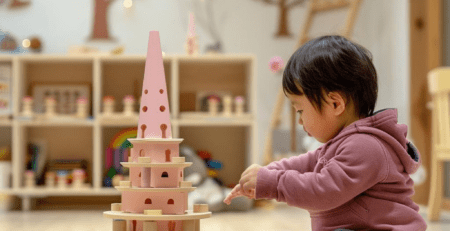
16
Unlocking Developmental Benefits with Associative Play: A Guide for Parents and Educators
Enter into the whimsical world of associative play, where imaginations run wild and creativity knows no bounds. In this article, we will explore the fascinating concept of associative play and the profound impact it has on child development. From fostering social skills to igniting a love for learning, associative play is a treasure trove of developmental benefits. So, buckle up and get ready to delve into the enchanting realm of associative play.
Table of Contents
- What is Associative Play?
- Benefits of Associative Play
- How to Encourage Associative Play in Children
- Developing Social Skills through Associative Play
- Creating a Supportive Environment for Associative Play
- Q&A
- Concluding Remarks
What is Associative Play?
Benefits of Associative Play
Associative play, also known as parallel play, is a crucial stage of a child’s social and emotional development. In this form of play, children begin to interact and play alongside each other without directly engaging in a common activity. This type of play has several benefits that contribute to a child’s overall growth and development.
One of the key benefits is that it encourages social interaction and communication skills. As children engage in parallel activities, they naturally observe and imitate each other, which helps them learn about verbal and non-verbal communication. This form of play also fosters the development of empathy and cooperation, as children begin to understand the feelings and emotions of their peers, and learn to work together towards common goals.
In addition, associative play promotes creativity and imagination. Children engage in independent play, which allows them to explore their interests and develop their own ideas. This type of play encourages problem-solving and critical thinking, as children navigate the complexities of playing alongside others while pursuing their own individual interests. associative play is a valuable stage in a child’s development, as it lays the groundwork for more complex forms of social interaction and collaborative play in the future.
How to Encourage Associative Play in Children
As children grow and develop, it’s essential to encourage a variety of play experiences to support their social, emotional, and cognitive development. Associative play is a type of play where children begin to interact with each other, sharing toys and engaging in activities, but without a formal structure or rules. This type of play is an important milestone in childhood development, as it helps children build their social skills, learn to cooperate, and develop their creativity and imagination.
Here are some tips on how to encourage associative play in children:
- Provide opportunities for group play: Create opportunities for children to interact and play together in a group setting. This could be through playdates, organized playgroups, or community events.
- Offer a variety of open-ended toys: Open-ended toys like blocks, playdough, and dress-up clothes can encourage children to engage in imaginative and cooperative play.
- Model positive social interactions: Children often learn by example, so it’s important for adults to model positive social interactions and communication skills when interacting with other children and adults.
- Facilitate communication and problem-solving: Encourage children to communicate and work together to solve problems during playtime, which can help them develop important social and cognitive skills.
Developing Social Skills through Associative Play
Associative play is a crucial stage in a child’s development that helps them learn social skills and build relationships with their peers. This type of play involves children playing alongside each other, rather than actively engaging in structured games or activities. Through associative play, children have the opportunity to observe and imitate one another, share toys and communicate, which can lead to the development of important social skills.
One of the key benefits of associative play is that it helps children learn how to interact with others in a positive and cooperative manner. They learn to take turns, share, and work together to achieve common goals, which are essential skills for navigating social situations later in life. Additionally, associative play allows children to practice their communication skills, as they learn to express their thoughts and ideas, and listen to others in a group setting.
This type of play also fosters the development of empathy and understanding towards others, as children learn to recognize and respect the feelings and needs of their playmates. As they engage in associative play, children may also be exposed to different perspectives and ways of thinking, which can help them develop a broader worldview and a more inclusive attitude towards others. associative play is an important aspect of a child’s social and emotional development, as it provides them with the foundation for healthy relationships and interactions with others.
Creating a Supportive Environment for Associative Play
Creating a supportive environment for associative play is essential for promoting social interaction and development in young children. Associative play, often seen in toddlers and preschoolers, involves children engaging in activities alongside each other without a structured or coordinated effort. This type of play allows children to observe and imitate each other, fostering social skills, communication, and cooperation. To encourage and support associative play, it’s important to create an environment that is conducive to social interaction and exploration.
Key Factors for Creating a Supportive Environment
- Open Space: Provide a designated play area that allows for ample space for children to move around and engage in activities.
- Age-Appropriate Toys and Materials: Offer a variety of toys and materials that are suitable for the developmental stage of the children, promoting creativity and exploration.
- Structured Activities: Incorporate structured activities and games that encourage teamwork and collaboration, laying the foundation for associative play.
- Positive Reinforcement: Praise and encourage positive interactions and sharing among children, reinforcing the importance of social engagement.
By creating a supportive environment for associative play, educators and parents can help children develop essential social skills and relationships that will benefit them throughout their lives.
Q&A
Q: What is associative play?
A: Associative play is a type of play where children interact with each other while participating in their own activities. They may share materials, take turns, and engage in simple conversations with each other.
Q: What are the benefits of associative play?
A: Associative play helps children develop social skills, cooperation, and communication. It also allows them to gain an understanding of others’ perspectives and promotes a sense of belonging and community.
Q: At what age do children typically engage in associative play?
A: Children typically start engaging in associative play around the age of 3 or 4, as they become more socially aware and begin to interact with their peers in more structured and cooperative ways.
Q: How can parents and caregivers encourage associative play?
A: Parents and caregivers can encourage associative play by providing opportunities for children to play with others in a supportive and supervised environment. They can also model positive social interactions and teach children the importance of taking turns and sharing.
Q: Are there any potential challenges with associative play?
A: Some children may struggle with the social aspect of associative play, such as sharing or communicating effectively with their peers. It’s important for adults to provide guidance and support to help children overcome these challenges.
Q: What role does associative play play in child development?
A: Associative play is an important aspect of child development as it helps children learn how to navigate social situations, cooperate with others, and form relationships. It also lays the groundwork for more complex forms of play and interaction as children grow older.
Concluding Remarks
Associative play is an essential aspect of child development, allowing children to engage in meaningful social interactions and build important skills for the future. By understanding the power of associative play, parents, educators, and caregivers can support and encourage children to engage in this type of play, promoting their social, emotional, and cognitive growth. As we continue to explore the world of child development, let us not underestimate the impact of associative play in shaping the minds and hearts of the next generation. Thank you for reading, and may we continue to foster environments that nurture the power of play in children’s lives.










